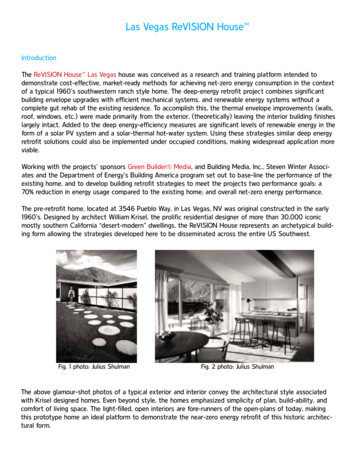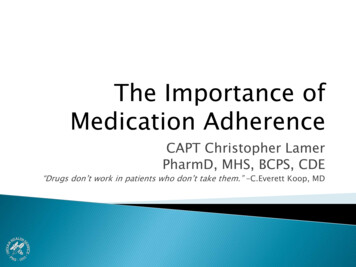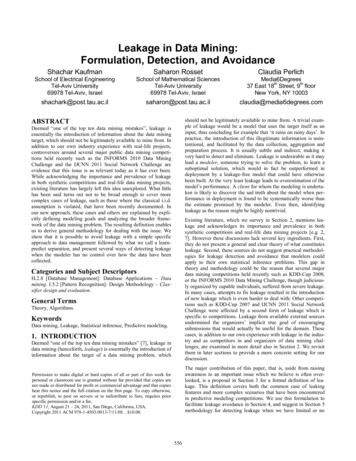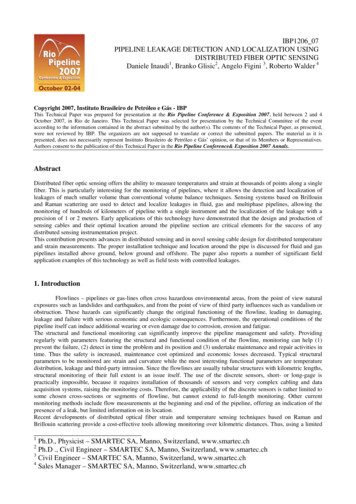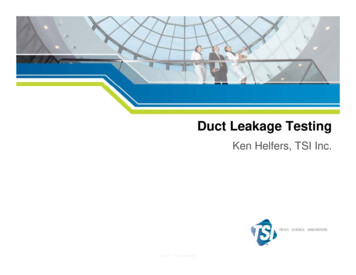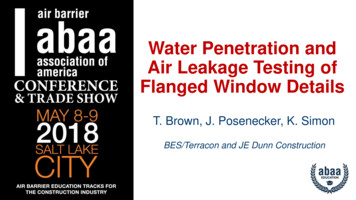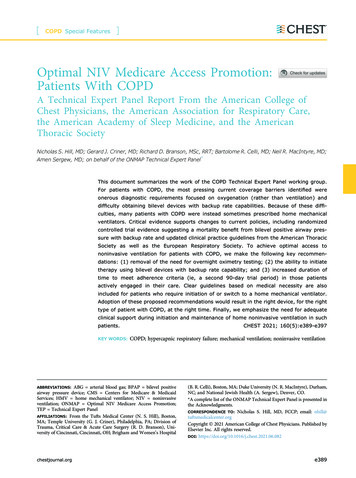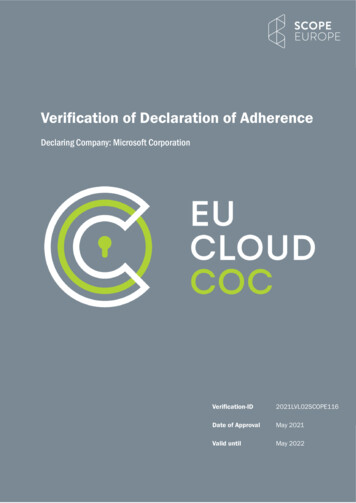
Transcription
Sains Malaysiana 51(5)(2022): ir Leakage and Adherence to Continuous Positive Airway Pressure Therapy inPatients with Moderate to Severe Obstruction Sleep Apnoea: A Cross SectionalStudy(Kebocoran Udara dan Pematuhan kepada Terapi Berterusan Tekanan Saluran Udara Positif Pesakit dengan ApneaTidur Halangan Sederhana hingga Teruk: Kajian Keratan Rentas)N ADIA S YAFEERA N ASERRUDIN1, A BDULLAH S ANI M OHAMED1, M AWADDAH A ZMAN1, M AZLINDA M AHADZIR2,N ORAZMI M OHAMAD3 & M ARINA M AT B AKI1,*Department of Otorhinolaryngology, Head and Neck Surgery, Faculty of Medicine, Universiti Kebangsaan MalaysiaMedical Centre, 6000 Kuala Lumpur, Federal Territory, Malaysia2Department of Otorhinolaryngology, Head and Neck Surgery, 50586 Hospital Kuala Lumpur, Kuala Lumpur, FederalTerritory, Malaysia3Department of Otorhinolaryngology, Head and Neck Surgery, 40000 Hospital Shah Alam, Selangor Darul Ehsan,Malaysia1Received: 21 June 2020/Accepted: 8 October 2021ABSTRACTThis multicentre study aimed to evaluate the air leakage following a palatal surgery and its effect on CPAP adherencein OSA patients. The data on air leakage and adherence were objectively obtained and evaluated from the recordedCPAP therapy data. Forty patients were divided into two groups: surgery (18 patients) and non-surgery (22 patients). Themean air leakage level was 7.62 8.14% and 12.62 13.81% and mean adherence was 51.44 35.27% and 60.03 27.04%for surgery and non-surgery, respectively. There was no significant difference in CPAP adherence (p 0.389) but for meanair leakage it was significantly higher in non-surgery (p 0.01). The occurrence of significant air leakage duringCPAP therapy was not associated with surgery (p 0.436). There was no association between poor CPAP adherence andsurgery (p 0.622). In terms of impact of palatal surgery, it did not cause significant leakage with no significant associationto poor adherence.Keywords: Adherence; anterior palatoplasty; continuous positive airway pressure therapy; leakage; obstructive sleepapnoeaABSTRAKPenyelidikan ini yang melibatkan beberapa institusi bertujuan untuk menilai kebocoran udara selepas pembedahanlelangit dan kesan ke atas kepatuhan pemakaian CPAP dalam kalangan pesakit OSA. Data kebocoran udara dankepatuhan didapati dan dinilai secara objektif melalui rekod daripada terapi CPAP. Empat puluh pesakit dibahagikankepada 2 kumpulan: surgeri (18 pesakit) dan non surgeri (22 pesakit). Tahap min kebocoran udara adalah 7.62 8.14%dan 12.62 13.81% dan min kepatuhan adalah 51.44 35.27% dan 60.03 27.04% untuk surgeri dan non surgeri. Tiadaperubahan signifikan di dalam kepatuhan CPAP (p 0.389) tetapi untuk min kebocoran udara menunjukkan nilaisignifikan yang lebih tinggi untuk non surgeri (p 0.01). Kejadian untuk signifikan kebocoran udara ketika penggunaanterapi CPAP adalah tiada kaitan dengan surgeri (p 0.436). Didapati tiada juga kaitan antara kepatuhan pemakaian CPAPyang teruk dan surgeri (p 0.622). Berkaitan dengan impak pembedahan lelangit, ia tidak menyebabkan kebocoransignifikan dan juga tiada kaitan signifikan terhadap keterukan kepatuhan.Kata kunci: Apnea tidur halangan; kebocoran; kepatuhan; palatoplasti anterior; terapi berterusan tekanan saluran udarapositifI NTRODUCTIONObstructive sleep apnoea (OSA) is a type of sleepdisorder characterised by recurrent partial or completepharyngeal obstruction during sleep (Strollo & Rogers1997). This results in neurocognitive, cardiovascular, andmetabolic disorders (Aurora & Punjabi 2013; Rosenzweig
et al. 2015; Sánchez-de-la-Torre et al. 2013). Therefore,it is crucial to treat OSA patients. CPAP therapy hasbeen the gold standard treatment (Sullivan et al. 1981).However, adherence to CPAP therapy remains an issuedue to problems related to mask fit, such as eye irritation,silicone allergies, pressure sores and air leaks (Neuzeret& Morin 2017). Air leakage is experienced by up to 50%of nasal CPAP users (Pépin et al. 1995).Air leakage can be divided into intentional andunintentional leaks. Intentional leaks are important toallow the exhalation of carbon dioxide. Unintentionalair leaks can be caused by leakage from weak mask seal,holes along the tubing and palatal surgery for OSA.Surgical modality is a treatment option for patientswho fail CPAP therapy. Common surgery performedat palatal level include uvulopalatopharyngoplasty(UPPP) , cautery assisted palatal stiffening operation(CAPSO), anterior palatoplasty, and their modification.Their aim is to induce fibrosis at soft palate to preventcollapse of the velopharynx during sleep. However, itis common that these patients would still need CPAPwhen the surgery failed to alleviate the symptoms andcure the OSA. Some studies showed that palatal fibrosisfollowing the surgery may compromise CPAP therapyby increased mouth air leak, leading to poor compliance(Mortimore et al. 1996; Richards et al. 1996), but otherstudies documented otherwise with improved outcomes(Chandrashekariah et al. 2008; Friedman et al. 2009).Thus, the results in the literature have been contradicting.The present study was performed to compare air leakagebetween surgery group (those who has underwentanterior palatoplasty with lateral wall release) andnon-surgery group and to investigate the associationof significant air leakage with the surgery. The studyalso investigated the effect of the surgery on adherenceto CPAP therapy among OSA patients. The hypothesisof this study is anterior palatoplasty would not causesignificant air leakage and do not affect the adherenceto CPAP therapy.M ATERIALS AND M ETHODSETHICAL CONSIDERATIONMulticentre ethics approval was obtained from theUniversiti Kebangsaan Malaysia Medical Centre EthicsCommittee (FF-2017-411) and Medical Research andEthics Committee (MREC) (NMRR-19-612-46902).STUDY DESIGN AND PARTICIPANTSWe conducted a cross sectional study from 1st September2017 to 30th July 2019 (23 months) at three tertiary centresin Malaysia. Based on convenience sampling, the studysample included patients with OSA on CPAP therapywho had or had not undergone anterior palatoplastywith lateral wall release during the period of 1st January2010 until 31st January 2019. The inclusion criteria werepatients designated as moderate to severe OSA, over 18years old and having been on CPAP therapy for minimumusage of at least 6 months. The recordings of data fromboth groups were only calculated after the first 3 monthsof usage of CPAP therapy. This is to avoid any bias dueto surgical effect in the surgery group and other issuesrelated to mask fitting and adjustment to CPAP machine.The exclusion criteria were sleep disorders other thanOSA and underwent concomitant upper airway surgeryother than anterior palatoplasty. They were then dividedinto surgery and non-surgery groups.STUDY INSTRUMENTSThe patients’ medical records and data were obtainedfrom their SD card in their own auto CPAP therapymachine (37 patients on Lowenstein SOMNObalancee, Germany and 3 patients on Lowenstein Prisma 20a,Germany). All patients were using nasal mask and has noissue with mask fitting. The pressure of autoCPAP modewere set between 4hPa and 16hPa. Parameters that wereextracted include percentage of leakage, adherence andAHI. Adherence is defined by Centre of Medicaid andMedicare Services (CMS) rules as use of the CPAP devicefor at least 4 hours per night for at least 70% of nightsduring any given consecutive 30-day period (AmericanMedical Association 2010). Unintentional leak of morethan 10% is considered as significant leak based on theproduct information sheet. The AHI levels were groupedas normal ( 5), mild ( 5-15), moderate ( 15-30) or severe( 30) (The Report of an American Academy of SleepMedicine Task Force 1999). All data recordings wereobtained from the therapy data from their CPAP therapymachine, and we do not assess feedback subjectivelyfrom patients in terms of their experience with air leakageand adherence to avoid recall bias.SURGICAL TECHNIQUE OF ANTERIOR PALATOPLASTYWITH LATERAL WALL RELEASEThe anterior palatoplasty that was performed used similartechnique in all three centres. It is a modification fromPang and Terries’s technique. They described a formof palatoplasty in 2007 consisting of uvulectomy andremoval of horizontal strip of mucosa at the soft palate(Pang & Terris 2007).In the same year, further modification to the surgicaltechnique was done which consisted of tonsillectomy,
1507expansion sphincter pharyngoplasty, rotation ofpalatopharyngeus muscle, a partial uvulectomy andclosure of the anterior and posterior tonsillar pillars (Pang& Woodson 2007).Our anterior palatoplasty consisted oftonsillectomy, partial uvulectomy, resection of horizontalstrip of soft palate mucosa and lateral pharyngoplasty.For the lateral wall release, horizontal incision was madeat the middle part of both anterior and posterior pillarsuntil the pillars blended with the lateral pharyngealwall (Figure 1(a) to 1(c)). We do not perform theadditional procedure in anterior palatoplasty byPang and Terris’s which is the expansion sphincterpharyngoplasty, rotation of palatopharyngeus muscleand closure of anterior and posterior tonsillar pillars.In this study results, patients who had undergone anteriorpalatoplasty with lateral wall release were labelled assurgery and those without surgery were labelled as nonsurgery. None of the patients develop surgical relatedcomplications such as vellopharyngeal insufficiency.STATISTICAL ANALYSISThe data were analysed using the Statistical Packagefor the Social Science (SPSS) software version 23.Kolmogorov-Smirnov test was applied to test fornormality of data of surgery and non-surgery group.Independent t-test was used to compare the mean of airleakage as well as adherence between surgery andnon-surgery group. Chi-square test was used to assess theassociation of significant leakage as well as adherencebetween surgery and non-surgery group. A p-value ofless than 0.05 was considered as statistically significant.RESULTS AND DISCUSSIONRESULTS DEMOGRAPHYA total of 40 of 54 patients fulfilled the study criteriawith a male to female ratio of 4.7:1. The mean age forsurgery group was younger than non-surgery group; inwhich it was of 42.17 9.68 years versus 58.73 15.12years. Majority of the patients were obese (67.5%). Themean body mass index (BMI) and pre-CPAP AHI betweenthe 2 groups were similar (p 0.05) (Table 1).COMPARISON OF MEAN OF AIR LEAKAGE ANDADHERENCE OF CPAP THERAPYThe mean air leakage between surgery and non-surgerygroups were of 7.62 8.14% and 12.62 13.81%,respectively. The mean adherence levels of the surgeryand non-surgery groups were of 51.44 35.27% and60.03 27.04%, respectively. There was a significantdifference for mean air leakage; which was higherin non-surgery group (p 0.01). Comparison of meanadherence to CPAP therapy between the two groupsshowed no significant difference (p 0.389).ASSOCIATION OF SIGNIFICANT AIR LEAKAGE INSURGERY AND NON-SURGERY GROUPMajority of patients in this study did not havea significant air leakage (60.0%) during usage ofCPAP therapy. For surgery group, 6 patients (33.3%)experienced significant air leakage and 10 patients(45.5%) of the non-surgery had significant air leakage.This data showed that there was no association betweensignificant air leakage and surgery (p 0.436) (Table 2).ASSOCIATION OF ADHERENCE OF CPAP THERAPY INSURGERY AND NON-SURGERY GROUPCPAP adherence data from the report showed thatmajority of the patients from both groups were notadherent to CPAP therapy (62.5%). The data also showedthat 6 patients from the surgery group and 9 patientsfrom the non-surgery group were compliant with CPAPtherapy. 66.7% and 59.0% of the surgery and nonsurgery groups showed poor adherence, respectively.There was no association found between poor CPAPadherence and surgery (p 0.622) (Table 3).DISCUSSIONOSA causes many metabolic and neurocognitivemorbidities that may be reversed by good adherenceto CPAP therapy. One of the factors that contributeto non-adherence is air leakage. Since 1996, palatalsurgeries have shown heterogeneity in results towardsair leakage. Initial studies demonstrated increased airleakage following palatal surgeries (Mortimore et al.1996; Richards et al. 1996). Subsequent studies showedthat palatal surgery was more effective in the mild tomoderate OSA with less encouraging results in moderateto severe group (Friedman et al. 2017, 2009; Han et al.2006; Pang & Terris 2007; Pang & Woodson 2007).The present study’s main aim was to investigatewhether a standardised palatal surgery for OSA(anterior palatoplasty) would cause significant airleakage in CPAP therapy, thus affecting adherence tothe treatment. The results showed that surgery did notcause significant air leakage during CPAP therapy asthere was no significant association found between
significant air leakage and surgery. Majority (62.5%) ofOSA patients in this study were not adherent to CPAPtherapy. Comparison of mean CPAP adherence betweenthe two groups (surgery and non-surgery) was notstatistically significant (p 0.05). The result also showedthat there was no significant association between pooradherence and surgery.Previous studies showed conflicting results onthe impact of the upper airway surgery towards airleakage on CPAP therapy. The initial study on theeffects of palatal surgery (uvulopalatopharyngoplasty,UPPP) to CPAP therapy was conducted by MortimoreIL and demonstrated significant air leakage followingthe palatal surgery (Mortimore et al. 1996). They alsoconcluded that a significant reduction in adherenceto CPAP therapy following surgery was attributed bythe significant air leakage. However, in this study, theair leakage tests were conducted in awake patients.Therefore, the study’s conclusions were arguable, asthe findings may not be representative of the conditionduring natural sleep.On the other hand, another study which includeda one arm, small case series showed significantimprovements in mean adherence following an upperairway surgery by 49 minutes per night (p 0.03)(Chandrashekariah et al. 2008). However, the surgicalintervention performed in this study population wasnot standardised. Friedman et al. (2009) studied theadherence to CPAP therapy in 52 patients undergoingmultilevel surgery that comprised U3P, tongue basereduction and nasal procedures. They demonstrated thatthe adherence improved significantly comparing beforeand after the multilevel surgery that includes anteriorpalatal surgery. The study concluded that the overallsurgical intervention to the upper airway may be thecontributing factor to the significant improvement inCPAP therapy adherence. 96.2% of the study populationwere able to maintain optimal pressure without mouthleak.Han et al. (2006) studied 62 patients with OSA.Among the 31 who had UPPP, 24 patients had classicalUPPP which had removal of all of uvula and soft palateand the remaining 7 patients had modified UPPP whichkept part of the uvula. They demonstrated that all inmodified UPPP group could tolerate CPAP therapy butonly 5 patients (16%) who underwent classical UPPPcould not tolerate CPAP therapy. The authors concludedthat UPPP with greater resection of soft palate maycompromise CPAP therapy, and this may be attributedby presence of significant air leakage (Han et al. 2006).However, none of these studies included quantitativeair leak as the objective parameter.TABLE 1. The table depicts the demographic data that were recruited in the studySurgery(n 18)Nonsurgery(n 22)Total(n 40) (%)p-value15 (37.5%)18 (45.0%)33 (82.5%)0.9003 (7.5%)4 (10.0%)7 (17.5%)18-301 (2.5%)1 (2.5%)31-6015 (37.5%)11 (27.5%)2 (5.0%)10 (25.0%)42.17 9.6858.73 15.12Normal1 (2.5%)3 (7.5%)Overweight (25-29.9)3 (7.5%)6 (15.0%)Obese ( 30)14 (35.0%)13 (32.5%)Mean SD34.92 6.4331.71 6.25Moderate (15-29.9)5 (12.5%)Severe ( 30)13 (32.5%)DemographicGenderMaleFemaleAge 60Mean SD0.0612 (5.0%)26 (65.0%)12 (30.0%)BMI (kg/m2) 0.0010.4374 (10.0%)9 (22.5%)27 (67.5%)0.1198 (20.0%)13 (32.5%)0.56414 (35.0%)27 (67.5%)AHI pre CPAP (per hour)
1509To the best of authors’ knowledge, to date, thepresent study is the only study with a single type,standardised palatal surgery which is the anteriorpalatoplasty that were compared to non-surgery groupthat look into the aspect of air leakage during CPAPtherapy and adherence to CPAP therapy. We have triedto minimize the other contributory factors towards airleakage by sampling only after ample period of 3 monthsof adjustment to CPAP therapy as well as in patientswith no issue with mask fitting. Our study supportsthe findings of previous studies showing that palatalsurgeries did not affect the subsequent CPAP treatment.Therefore, the authors believed that anterior palatoplastycan be remained as an option to facilitate CPAP therapyin patients who failed or refuse initial CPAP therapy.The main limitation of this study was the smallnumber of patients. The data on air leakage before andafter surgery were not available for comparison purpose.This is because most of the patients in surgery group hadrefused CPAP therapy as the primary treatment. A largerprospective study in future that include patients whohad anterior palatoplasty and sequentially requiringCPAP therapy due to surgical failure is recommendedto confirm the present study’s findings.TABLE 2. The air mask leakage in surgery and non-surgery groupLeakageSurgeryNon-surgeryTotalSignificant leakage6 (15.0%)10 (25.0%)16 (40.0%)Non significant leakage12 (30.0%)12 (30.0%)24 (60.0%)p-value0.436TABLE 3. The adherence to CPAP therapy in surgery and non-surgery groupAdherenceSurgeryNon-surgeryTotalGood adherence ( 70%)6 (15.0%)9 (22.5%)15 (37.5%)Poor adherence ( 70%)12 (30.0%)13 (32.5%)25 (62.5%)p-value0.622FIGURE 1. (a) Illustration of steps of anterior palatoplasty, which includes tonsillectomy, partialuvulectomy, resection of soft palate mucosa and lateral wall release (b) and (c) Intraoperative view ofanterior palatoplasty with lateral wall release in which: (a) mucosa of the soft palate was resected (blackarrow); and (b) resected mucosa of the soft palate was sutured (black arrow). Partial uvulectomy (whitearrow), tonsillectomy (curved thin arrow) and lateral wall release (straight thin arrow) were performed
C ONCLUSIONThis study demonstrated that anterior palatoplasty withlateral wall release did not cause negative impact to thesubsequent CPAP therapy in OSA patient. The mean airleakage during CPAP therapy was higher in non-surgerygroup and the presence of significant air leakage wasnot associated with surgery. Poor adherence to CPAPtherapy has no significant association with surgery.REFERENCESAmerican Medical Association. 2010. National GovernmentServices, Inc. LCD for Positive Airway Pressure (PAP)Devices for the Treatment of Obstructive Sleep Apnea(L27230); Center for Medicaid and Medicare. http://www.nationwidemedical.com/wp-content -region-b.pdf.Aurora, R.N. & Punjabi, N.M. 2013. Obstructive sleep apnoeaand type 2 diabetes mellitus: A bidirectional association.The Lancet Respiratory Medicine 1(4): 329-338.Chandrashekariah, R., Shaman, Z. & Auckley, D. 2008.Impact of upper airway surgery on CPAP compliance indifficult-to-manage obstructive sleep apnea. Archives ofOtolaryngology- Head & Neck Surgery 134(9): 926-930.Friedman, M., Salapatas, A.M. & Bonzelaar, L.B. 2017. UpdatedFriedman staging system for obstructive sleep apnea.Advances in Oto-Rhino-Laryngology 80: 41-48.Friedman, M., Soans, R., Joseph, N., Kakodkar, S. & Friedman,J. 2009. The effect of multilevel upper airway surgery oncontinuous positive airway pressure therapy in obstructivesleep apnea/hypopnea syndrome. The Laryngoscope 119(1):193-196.Han, F., Song, W., Li, J., Zhang, L., Dong, X. & He, Q. 2006.Influence of UPPP surgery on tolerance to subsequentcontinuous positive airway pressure in patients withOSAHS. Sleep and Breathing 10(1): 37-42.Mortimore, I.L., Bradley, P.A., Murray, J.A. & Douglas, N.J.1996. Uvulopalatopharyngoplasty may compromise nasalCPAP therapy in sleep apnea syndrome. American Journalof Respiratory and Critical Care Medicine 154(6): 17591762.Neuzeret, P-C. & Morin, L. 2017. Impact of different nasalmasks on CPAP therapy for obstructive sleep apnea: Arandomized comparative trial. The Clinical RespiratoryJournal 11(6): 990-998.Pang, K.P. & Terris, D.J. 2007. Modified cautery-assisted palatalstiffening operation: New method for treating snoring andmild obstructive sleep apnea. Otolaryngology - Head andNeck Surgery 136(5): 823-826.Pang, K.P. & Woodson, T. 2007. Expansion sphincterpharyngoplasty: A new technique for the treatment ofobstructive sleep apnea. Otolaryngology - Head and NeckSurgery 137(1): 110-114.Pépin, J.L., Leger, P., Veale, D., Langevin, B., Robert, D. &Lévy, P. 1995. Side effects of nasal continuous positiveairway pressure in sleep apnea syndrome. Study of 193patients in two French sleep centers. Chest 107(2): 375381.Richards, G.N., Cistulli, P.A., Ungar, R.G., Berthon-Jones, M.& Sullivan, C.E. 1996. Mouth leak with nasal continuouspositive airway pressure increases nasal airway resistance.American Journal of Respiratory and Critical CareMedicine 154(1): 182-186.Rosenzweig, I., Glasser, M., Polsek, D., Leschziner, G.D.,Williams, S.C.R. & Morrell, M.J. 2015. Sleep apnoea andthe brain: A complex relationship. The Lancet RespiratoryMedicine 3(5): 404-414.Sánchez-de-la-Torre, M., Campos-Rodriguez, F. & Barbé, F.2013. Obstructive sleep apnoea and cardiovascular disease.The Lancet Respiratory Medicine 1(1): 61-372.Strollo, P.J. & Rogers, R.M 1996. Obstructive sleep apnea. TheNew England Journal of Medicine 334(2): 99-104.Sullivan, C.E., Issa, F.G., Berthon-Jones, M. & Eves, L. 1981.Reversal of obstructive sleep apnoea by continuous positiveairway pressure applied through the nares. The Lancet1(8225): 862-865.The Report of an American Academy of Sleep MedicineTask Force. 1999. Sleep-related breathing disorders inadults: Recommendations for syndrome definition andmeasurement techniques in clinical research. Sleep 22(5):667-689.*Corresponding author; email: marinamatbaki@ppukm.ukm.edu.my
patients. The data on air leakage and adherence were objectively obtained and evaluated from the recorded . CPAP. therapy data. Forty patients were divided into two groups: surgery (18 patients) and non-surgery (22 patients). The mean air leakage level was 7.62 8.14% and 12.62 13.81% and mean adherence was 51.44 35.27% and 60.03 27.04%

